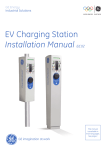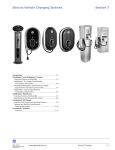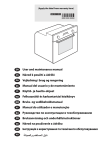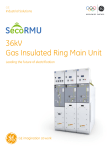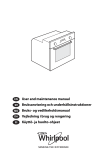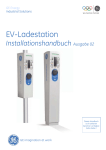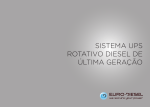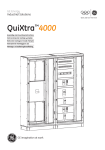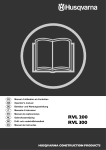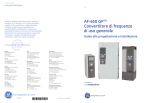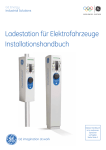Download Maintenance Manual - Gepowercontrols.com
Transcript
GE Energy Industrial Solutions EV Charging Station Maintenance Manual Ed.02 This manual is available in more languages. See page 2 GE imagination at work DuraStation™ EV Charging Station More Languages FRANÇAIS Vous pouvez télécharger le manuel d’entretien: www.ge.com/fr/industrialsolutions www.ge.com/be/industrialsolutions Vous pouvez commander un exemplaire sur papier par le code 451127 ESPAÑOL Descarga el Manual de Mantenimiento en: www.ge.com/es/industrialsolutions Puede solicitar la versión impresa con el código 451125 ITALIANO Il manuale di manutenzione può essere scaricato da: www.ge.com/it/industrialsolutions La versione stampata è ordinabile con codice 451128 PORTUGUÊS O Manual de Manutenção pode ser descarregado em: www.ge.com/pt/industrialsolutions Está igualmente disponível em versão papel. Para pedir exemplares, utilize o código 451131 DEUTSCH Die Wartungshandbuch kann hier heruntergeladen werden: www.ge.com/de/industrialsolutions Die gedruckte Version können Sie mit der Nr. 451122 bestellen. NEDERLANDS Voor de onderhoudshandleiding surf naar: www.ge.com/nl/industrialsolutions www.ge.com/be/industrialsolutions Een gedrukt exemplaar kan besteld worden met code 451129 SUOMEN SVENSKA Huolto-opas ovat ladattavissa: www.ge.com/fi/industrialsolutions Painettu versio on tilattavissa tuotekoodilla 451126 Underhållshandbok can laddas ner på: www.ge.com/fi/industrialsolutions Tryckt version kan beställas med produktkoden 451123 DANSK Service og vedligeholdelses manual kan downloaded’s: www.ge.com/fi/industrialsolutions Printet version kan bestilles med kode 451121 NORSK ENGLISH This Maintenance Manual can be downloaded: www.ge.com/ex/industrialsolutions www.ge.com/uk/industrialsolutions Extra printed versions can be ordered with code 451124 2 Vedlikeholdsmanual kan nedlastes fra: www.ge.com/fi/industrialsolutions Papirversjon kan bestilles med kode 451130 DuraStation™ EV Charging Station Maintenance Procedures Maintenance Manual Ed.02 INDEX 1. Safety and Compliance. . . . . . . . . . . . . . . . . . . . . . . . . . . . . . . . . . . . . . . . . . . . . . . . . . . . . . 4 2. Definition and Terms . . . . . . . . . . . . . . . . . . . . . . . . . . . . . . . . . . . . . . . . . . . . . . . . . . . . . . . 4 3. Technical Data . . . . . . . . . . . . . . . . . . . . . . . . . . . . . . . . . . . . . . . . . . . . . . . . . . . . . . . . . . . 5 3.1. Technical characteristics . . . . . . . . . . . . . . . . . . . . . . . . . . . . . . . . . . . . . . . . . . . . . . . . 5 3.2. Catalogue data . . . . . . . . . . . . . . . . . . . . . . . . . . . . . . . . . . . . . . . . . . . . . . . . . . . . . . 6 3.2.1. TN-S distribution system . . . . . . . . . . . . . . . . . . . . . . . . . . . . . . . . . . . . . . . . . . . . . . 6 3.2.2. TN-S with surge arrestor . . . . . . . . . . . . . . . . . . . . . . . . . . . . . . . . . . . . . . . . . . . . . . 6 3.2.3. TN-C distribution system . . . . . . . . . . . . . . . . . . . . . . . . . . . . . . . . . . . . . . . . . . . . . . 6 4. 5. 6. 3.3. Torque specification . . . . . . . . . . . . . . . . . . . . . . . . . . . . . . . . . . . . . . . . . . . . . . . . . . . 7 3.4. Tools . . . . . . . . . . . . . . . . . . . . . . . . . . . . . . . . . . . . . . . . . . . . . . . . . . . . . . . . . . . . . 7 3.5. Contact blocks . . . . . . . . . . . . . . . . . . . . . . . . . . . . . . . . . . . . . . . . . . . . . . . . . . . . . . . 7 System Description. . . . . . . . . . . . . . . . . . . . . . . . . . . . . . . . . . . . . . . . . . . . . . . . . . . . . . . . 8 4.1. Enclosure . . . . . . . . . . . . . . . . . . . . . . . . . . . . . . . . . . . . . . . . . . . . . . . . . . . . . . . . . . 8 4.2. Power circuit . . . . . . . . . . . . . . . . . . . . . . . . . . . . . . . . . . . . . . . . . . . . . . . . . . . . . . . . 9 4.3. Network management . . . . . . . . . . . . . . . . . . . . . . . . . . . . . . . . . . . . . . . . . . . . . . . . . . 9 General Operations & Safety Requirements. . . . . . . . . . . . . . . . . . . . . . . . . . . . . . . . . . . . . . . . 10 5.1. General maintenance requirements. . . . . . . . . . . . . . . . . . . . . . . . . . . . . . . . . . . . . . . . . 10 5.2. Enclosure maintenance requirements . . . . . . . . . . . . . . . . . . . . . . . . . . . . . . . . . . . . . . . 10 5.3. Power circuit maintenance requirements . . . . . . . . . . . . . . . . . . . . . . . . . . . . . . . . . . . . . 11 5.4. Cable maintenance requirements . . . . . . . . . . . . . . . . . . . . . . . . . . . . . . . . . . . . . . . . . . 12 5.5. Gaskets maintenance requirements. . . . . . . . . . . . . . . . . . . . . . . . . . . . . . . . . . . . . . . . . 12 Replacing Components. . . . . . . . . . . . . . . . . . . . . . . . . . . . . . . . . . . . . . . . . . . . . . . . . . . . . 13 6.1. Controller PCB. . . . . . . . . . . . . . . . . . . . . . . . . . . . . . . . . . . . . . . . . . . . . . . . . . . . . . . 13 6.2. Socket . . . . . . . . . . . . . . . . . . . . . . . . . . . . . . . . . . . . . . . . . . . . . . . . . . . . . . . . . . . 13 6.3. LED . . . . . . . . . . . . . . . . . . . . . . . . . . . . . . . . . . . . . . . . . . . . . . . . . . . . . . . . . . . . . 15 6.4. RFID . . . . . . . . . . . . . . . . . . . . . . . . . . . . . . . . . . . . . . . . . . . . . . . . . . . . . . . . . . . . . 17 6.5. Gaskets. . . . . . . . . . . . . . . . . . . . . . . . . . . . . . . . . . . . . . . . . . . . . . . . . . . . . . . . . . . 18 6.6. Cable glands and screw plugs . . . . . . . . . . . . . . . . . . . . . . . . . . . . . . . . . . . . . . . . . . . . 19 6.7. EVSE kiosk . . . . . . . . . . . . . . . . . . . . . . . . . . . . . . . . . . . . . . . . . . . . . . . . . . . . . . . . 19 3 DuraStation™ 1. Safety and Compliance This document provides instructions to properly maintain and service the DuraStation products included in section 3.2. Catalogue data. EV Charging Station Once installing the DuraStation, you should review this manual carefully and consult with a licensed contractor, licensed electrician, and trained installation expert to insure compliance with local building codes, climate conditions, safety standards and wiring regulations. Only a licensed contractor, and a licensed electrician in accordance with all local and national codes and standards should perform the maintenance of the DuraStation. Under no circumstances will compliance with the information in this maintenance manual relieve the user of his/her responsibility to comply with all applicable codes, safety standards or wiring regulation. Intent of this service manual is to lend a hand to maintenance personnel in diagnosing and repairing filed units; and also, to assist in establishing when a suspicious behavior is not a failure. 2. Definition and Terms • EV: Electrical Vehicle • EVSE: Electric Vehicle Supply Equipment • EV Charging station = Charging station = EVSE • PE: Protective Earth 4 DuraStation™ 3. Technical Data DuraStation has a list of basic features that are upgradeable, resulting in a robust and reliable solution for the need of EV charging infrastructure. Maintenance Procedures • The socket satisfies mode 3 charging standards, and is optionally equipped with an electromechanical interlock. • LED light to display charger status: Green= Station active Blinking Green= Vehicle connected, but not charging Amber= Charging Red= Fault occurred • Option for a Radio Frequency Identification (RFID) reader: users will gain charging authorization by swiping RFID cards in front of the readers. • Ethernet network offered for RFID authorization service. • RFID software application registers usage of the EVSE enabling data collection and will also monitor status of communication between RFID and DuraStation. • Residual current protection and auto re-closure. • Vehicle ground monitoring circuit. • Single phase metering. 3.1. Technical Characteristics IEC Compliant Mode 3 per IEC 61851 Vehicle Interface Type 2 connector per IEC 62196 Voltage and Current Rating 230VAC at 16A or 400VAC at 32A AC Max. Charging Power Output** 22kW (400VAC at 32A) 3.6kW (230VAC at 16A) AC Power Input 230VAC requiring only L1, N, and PE 400VAC requiring only L1, L2, L3, N and PE Recommended Panel Breaker Compact pedestal, Pole, Wall: 1x4-pole 40A , or 2-pole 20A breaker on dedicated circuit Back-to-back pedestal: 2x4-pole 40A, or 2-pole 20A breaker on dedicated circuit Ground Fault Protection Internal 30mA RCD with auto re-closure Cold Load Start Random start up between 0 and 15 minutes for peak protection Local Area Network CAT5 Ethernet Network Communication Protocol TCP/IP RFID Reader ISO15693 and ISO14443 compliant Standby Power 5W typical Outdoor Rated Enclosure IP54-IK10, socket outlet IP44 Safety Compliance IEC 61851 and IEC 62196 compliant CE Marking Certification Low Voltage (2006/95/EG) and EMC Directive (2004/108EC). Resistance against surges IEC 61851 compliant EMI Compliance IEC 61851 compliant Operating Temperature -30°C to +50°C ambient Operating Humidity Up to 95% non-condensing Approximate Shipping Weights Compact pedestal: 30kg Back-to-back pedestal: 45kg Pole: 25kg Wall: 25kg Dimensions HxWxD (in mm) Compact pedestal: 1300 x 275 x 200 Back-to-back pedestal: 1300 x 350 x 300 Pole: 800 x 237 x 200 Wall: 800 x 237 x 200 ** The maximum available power consumption is determined by the DuraStation. The actual power consumption is determined by the EV. 5 DuraStation™ 3.2. Catalogue data 3.2.1. TN-S distribution system For use in electrical distribution systems of type TN-S, the following products are available: EV Charging Station Cat No. EVSPE16A1P1N EVSPE32A3P1N EVSPE16A1P2N EVSPE32A3P2N EVSPE16A1P1R EVSPE32A3P1R EVSPE16A1P2R EVSPE32A3P2R EVSWA16A1P1N EVSWA32A3P1N EVSWA16A1P1R EVSWA32A3P1R EVSPO16A1P1N EVSPO32A3P1N EVSPO16A1P1R EVSPO32A3P1R Ref. No. 450100 450101 450102 450103 450104 450105 450106 450107 450108 450109 450110 450111 450112 450113 450114 450115 Type Pedestal Pedestal Pedestal Pedestal Pedestal Pedestal Pedestal Pedestal Wall Wall Wall Wall Pole Pole Pole Pole Max. Output 230V 16A 1 phase 400V 32A 3 phase 230V 16A 1 phase 400V 32A 3 phase 230V 16A 1 phase 400V 32A 3 phase 230V 16A 1 phase 400V 32A 3 phase 230V 16A 1 phase 400V 32A 3 phase 230V 16A 1 phase 400V 32A 3 phase 230V 16A 1 phase 400V 32A 3 phase 230V 16A 1 phase 400V 32A 3 phase No. of Sockets 1 1 2 2 1 1 2 2 1 1 1 1 1 1 1 1 RFID N N N N Y Y Y Y N N Y Y N N Y Y Integrated Meter Single phase Singe phase Single phase Single phase Single phase Single phase Single phase Single phase Single phase Single phase Single phase Single phase Single phase Single phase Single phase Single phase 3.2.2. TN-S with surge arrestor In certain electrical systems the DuraStation power circuit has to include an impulse surge arrestor device to comply with the local regulations or the conditions of the application. See products below for this requirement: Cat No. EVSPE16A1P1N-SA EVSPE32A3P1N-SA EVSPE16A1P2N-SA EVSPE32A3P2N-SA EVSPE16A1P1R-SA EVSPE32A3P1R-SA EVSPE16A1P2R-SA EVSPE32A3P2R-SA EVSWA16A1P1N-SA EVSWA32A3P1N-SA EVSWA16A1P1R-SA EVSWA32A3P1R-SA Ref. No. 450131 450133 450139 450141 450132 450134 450140 450142 450135 450137 450136 450138 Type Pedestal Pedestal Pedestal Pedestal Pedestal Pedestal Pedestal Pedestal Wall Wall Wall Wall Max. Output 230V 16A 1 phase 400V 32A 3 phase 230V 16A 1 phase 400V 32A 3 phase 230V 16A 1 phase 400V 32A 3 phase 230V 16A 1 phase 400V 32A 3 phase 230V 16A 1 phase 400V 32A 3 phase 230V 16A 1 phase 400V 32A 3 phase No. of Sockets 1 1 2 2 1 1 2 2 1 1 1 1 RFID N N N N Y Y Y Y N N Y Y Integrated Meter Single phase Singe phase Single phase Single phase Single phase Single phase Single phase Single phase Single phase Single phase Single phase Single phase RFID N N N N Y Y Y Y N N Y Y Integrated Meter Single phase Singe phase Single phase Single phase Single phase Single phase Single phase Single phase Single phase Single phase Single phase Single phase 3.2.3. TN-C distribution system In TN-C electrical distribution systems, the following DuraStation products are considered: Cat No. EVSPE16A1P1N-NC EVSPE32A3P1N-NC EVSPE16A1P2N-NC EVSPE32A3P2N-NC EVSPE16A1P1R-NC EVSPE32A3P1R-NC EVSPE16A1P2R-NC EVSPE32A3P2R-NC EVSWA16A1P1N-NC EVSWA32A3P1N-NC EVSWA16A1P1R-NC EVSWA32A3P1R-NC Ref. No. 450143 450145 450151 450153 450144 450146 450152 450154 450147 450149 450148 450150 Type Pedestal Pedestal Pedestal Pedestal Pedestal Pedestal Pedestal Pedestal Wall Wall Wall Wall Max. Output 230V 16A 1 phase 400V 32A 3 phase 230V 16A 1 phase 400V 32A 3 phase 230V 16A 1 phase 400V 32A 3 phase 230V 16A 1 phase 400V 32A 3 phase 230V 16A 1 phase 400V 32A 3 phase 230V 16A 1 phase 400V 32A 3 phase No. of Sockets 1 1 2 2 1 1 2 2 1 1 1 1 CAUTION: In TN-C Networks, ensure that all earth connections are the same point, and also neutral and earth functions are combined. Refer to “Installation Instruction” manual for more details about wiring and distribution systems. 6 DuraStation™ 3.3. Torque specification Size Recommended Torque (N.m) LED 0.5 M3 2.1 M4 RFID reader 1.2 M4 Connector (recommended by supplier Mennekes) 1.2 M5 Maintenance Procedures M5 1.4 3.4. Tools Type Characteristics Screwdriver Used in wiring connections Hexagonal key Socket size: 19mm Wire stripper 3.5. Contact blocks Type range Size 1 Single wire (solid) (min-max) mm2 1 Single wire (semi-solid) (min-max) mm2 2 Single wires (semi-solid) (min-max) mm2 1 Stranded (flexible) (min-max) mm2 2 Stranded (flexible) (min-max) mm2 Rated conductor cross-section RK 35 (Phases) M6 2.5-16 2.5-50 16-16 2.5-35 2.5-16 35 SL 35 (Earthing) M6 2.5-16 2.5-50 16-16 2.5-35 2.5-16 35 WARNING: De-energize equipment before performing any work on the installation. Make sure that the main breaker of the DuraStation is locked out, as well as the upstream breaker in the distribution panel. (This is achieved with accessory KS 644929 in both cases) 7 DuraStation™ 4. System Description Maintenance for the charging station is divided into the following sub-systems: 4.1. Enclosure EV Charging Station The surrounding case provides protection to personnel against incidental contact with the enclosed equipment or parts that involve risk. It also provides a degree of protection to the enclosed equipment against specified environmental conditions or reduces the risk of propagation of flame, sparks, and molten metal initiated by an electrical disturbance occurring within. The following devices are contained within the enclosure: • LED: User interface • Socket • RFID: User identification system • Maintenance door LED RFID Maintenance door Socket Figure 1: Enclosure 8 DuraStation™ 4.2. Power Circuit Group of devices arranged in such a way that will protect the system from overcurrents, short-circuits, electric shock, reinforcing insulation or conducting potential fault and residual currents to earthed point. Maintenance Procedures • Contactor • MCB (Miniature Circuit Breaker) • RCD (Residual Current Device; earth leakage detection) • Tele MP (reconnection device) Controller PCB RCD Tele MP Contactor MCB Contact blocks Figure 2: Power Circuit 4.3. Network management Keeps track of resources in the network, how they are assigned and their availability so as to provide users with a more efficient charging process. Refer to “Installation Instructions” manual for more details. 9 DuraStation™ 5. General Operations & Safety Requirements EV Charging Station Before Inspection or any maintenance work is done, be sure that all electrical power is disconnected. Make sure that the main breaker of the DuraStation is locked out, as well as the upstream breaker in the distribution panel. (This is achieved with accessory KS 644929 in both cases) 5.1. General Maintenance Requirements Periodic maintenance must be established in order to obtain the best service from the EVSE charger. An annual check of the switchgear devices and all connections should be the minimum requirement. Equipment subject to highly repetitive operation may require more frequent maintenance. A permanent record of all maintenance work should be kept. The record should include a list of periodic checks and tests made, the date they were made, the condition of the equipment, and any repairs or adjustments that were performed. Maintenance employees must follow all recognized safety practices, such as those contained in the National Electric Safety Code and in company or other safety regulations. For specific information regarding the maintenance of devices, such as circuit breakers, RCD, relays, meters, etc.. refer to the separate instruction book provided for each device. 5.2. Enclosure Maintenance Requirements The enclosure station requires no maintenance other than occasional cleaning. Warning: To reduce the risk of electrical shock or equipment damage, do not allow opening the unit while cleaning it. Enclosure maintenance is performed only externally. Clean the enclosure using a soft cloth lightly moistened with mild detergent solution. Never use any type of abrasive pad, scouring powder, or flammable solvents such as alcohol or benzene. 10 DuraStation™ 5.3. Power Circuit Maintenance Requirements Inspection of the power circuit is recommended at least once a month. • MCB, RCD, Tele MP If the breaker remains open or closed for a long period of time, it is recommended that arrangements be made to open and close it several times in succession, preferably under load. At all times, it is important not to permit paint, oil or other foreign materials to remain on the insulating surfaces or the breaker as they may cause low resistance between points of different potential and result in eventual electrical breakdown. Always inspect the devices after a short circuit current has been interrupted. Normally, the over current protective device on the circuit will prevent any electrical damage except at the actual point of the short circuit. Maintenance Procedures More frequent inspections are recommended, if several load conditions, dust, moisture, or other unfavourable conditions exist. A thorough inspection of the entire system must be made after any large fault current to insure that there has been no mechanical damage to conductors, insulation, or equipment. Do not open sealed devices such as breaker trip units. If there is any possibility that sealed units may have been damaged, they should be replaced. At the time of inspection, the following checks should be made after the device has been de-energized. - Manually operate the device several times checking for obstructions or excessive friction. - Electrically operate the device several times (if breaker has electrical control) to ascertain whether the electrical attachments are functioning properly. - Break-age of parts or extensive burning will indicate need for replacement. - Check operation of tripping devices, including over current trip devices, making sure all have positive tripping action. (Discernible movement in tripping direction beyond point of tripping). - Push test-button in the RCD device: positive tripping action (ensure RCD device is powered, therefor the contactor should be closed manually). • Contactor Ensure a trouble free operation of the contactor until the next service is required. As in the previous devices, always inspect the device after main breaker tripping. At the same time, observations can be made to judge if the contactor operates well in the application. Ensure that electrical continuity in all the poles is retained and should be operable in ON/trio/rest sequence manually. If there is any possibility the unit has been damaged, it should be replaced. For additional details on the particular device, refer to the applicable instruction manual provided with the device. 11 DuraStation™ • Impulse Surge Arrester (Refer to section 3.2.2) The surge arresters do not contain wearing parts and therefor, they are maintenance free. Replacement parts are not needed. Maintenance is based into a visual inspection of the following parts: Blank Fault indicator Red EV Charging Station - Check that the arrester housing is clean and free from where is installed. - The monitoring device for leakage current (Fault indicator) is reviewed as it is indicated. OK replace It is recommended to replace the units that caused the mechanically defect of the surge arrester. 5.4. Cable Maintenance Requirements Inspect and check the cables as follows: • Inspect all power cable connections for signs of overheating and tighten all connections. • If severe discoloration or if damage is apparent, remove the damaged cable and replace any device with damaged terminal. CAUTION: Be sure the condition which caused the over heating has been corrected before reenergizing. • Check the neutral bus and earth bus connection and mounting bolts for tightness. • Check that all wiring connections are tight and all control cabling is intact. 5.5. Gaskets Maintenance Requirements Gaskets require regular maintenance to prevent mold and mildew and to maintain the elasticity of the seal. Visually check the different gaskets or lid for tears or punctures. Leaks are indicated by a streak of frost that forms at the point of gasket failure. Gasket and retainer groove cleaning can be accomplished with the use of warm soapy water and a soft bristle brush. CAUTION: Avoid full strength cleaning products on gaskets as this can cause them to become brittle and prevent proper sealing. Never use sharp tools or knives to scrape or clean the gasket. This could tear the gaskets. 12 DuraStation™ 6. Replacing Components Before Inspection or any maintenance work is done, be sure that all electrical power is disconnected. Make sure that the main breaker of the DuraStation is locked out, as well as the upstream breaker in the distribution panel. (This is achieved with accessory KS 644929 in both cases) Maintenance Procedures 6.1. Controller PCB Turn circuit breaker off, verifying no power is applied. Open the enclosure door with its corresponding key. Remove the door carefully for improved access. The different connectors included in the controller are disconnected. (See connectors in blue in following picture) Figure 3: Controller PCB The four click supports that hold the controller are removed by pressing them. The broken PCB needs to be replaced by the new one. The new PCB is fixed to the enclosure in the same way, and all the connectors are installed again. Note: DuraStation charger configuration will be necessary for this new PCB. Please, follow the described steps in the provided “Charging Station Installation Instructions” manual. 6.2. Socket Turn the circuit breaker off, verifying no power is applied. Open the enclosure door with its corresponding key. Remove the door carefully for improved access. Uninstall the connector from the enclosure as is indicated: 1. Inside the enclosure, remove the interlock part from the connector (for this, unscrew the two screws as indicated in pictures below). Figure 4: Removing interlock - STEP 1: unscrew Figure 4: Removing interlock - STEP 2: remove Figure 5: Connector without interlock 13 DuraStation™ EV Charging Station 2. Then, unscrew the four screws that hold the socket in the enclosure. (See the following picture to distinguish the different parts of the connector). Figure 6: Socket assembly 3. Disconnect the different cables from the broken connector. 4. Replace the socket with the new one and connect the cables again. (Attention: Be sure to connect the cables correctly. See the below figure). Lock Proximity pilot (PP) Control pilot (CP) L1 N L2 L3 Earth Figure 7: Cables disposition 5. Finally fasten the connector again in the enclosure as indicated in step 2, and install the interlock as in the first step. (Attention: Do not over-tighten. Consider recommended torques in section 3.3. Torque specification), 6. Close the door and lock it. 14 DuraStation™ 6.3. LED Turn the circuit breaker off and verify that no power is applied. Open the enclosure door with its corresponding key. Remove the door carefully for improved access. Uninstall the LED assembly from the enclosure as indicated in the following steps: Maintenance Procedures Figure 8: LED assembly 1. Disconnect the LED connector from the controller PCB (J15). Figure 9: Controller PCB 2. Then, unscrew the four screws located inside the enclosure, that hold the LED metallic support in the charger. Figure 10: LED assembly 15 DuraStation™ EV Charging Station 3. Once the LED frame is out of the enclosure. The following steps are applied: The LED strip is included in the frame as shown, secured by internal screws. Replace the LED strip with a new one and secure it in the same way in the given frame. Figure 11: LED metallic support 4. Install the metallic support again into the enclosure as indicated in the following picture. (Attention: Do not over-tighten. Consider recommended torques noted in section 3.3. Torque specification). 5. Connect again the LED connector to the controller-PCB (J15) as in the first step. 6. Once completed, close and lock the door of the enclosure. 16 DuraStation™ 6.4. RFID Turn the circuit breaker off and verify that no power is applied. Open the enclosure door with its corresponding key. Remove the door carefully for improved access. Uninstall the RFID assembly from the enclosure as indicated in the following steps: Maintenance Procedures 1. Disconnect the RFID connector from the controller-PCB. Figure 12: Controller PCB 2. The cable of the card reader includes a ferrite. Remove the ferrite carefully, for that, introduce the connector two times through it as shown. 3. Unscrew the two screws located inside the enclosure, as it is shown in the following picture: Figure 13: RFID assembly 4. Carefully remove the old RFID reader located in the front of the Durastation. 17 DuraStation™ EV Charging Station 5. Open the old RFID reader by unscrewing the screw at the bottom, as shown below. 6. In the old RFID reader, remove the internal mounting piece, where two axles are welded, as shown in the following picture. Figure 14: RFID assembly 7. In the same order, place this mounting part in the new RFID sensor and replace the RFID reader in the enclosure. Attention: The cable of the card reader includes a ferrite. Ensure it is included in the new RFID with 2 turns in the cable as indicated in step 2. 8. Fasten the RFID reader in the enclosure as indicated in the step 1, screwing the two screws inside the enclosure. (Attention: Do not over-tighten. Consider recommended torques noted in section 3.3. Torque specification). 9. Connect again the RFID connector to the controller-PCB as in the first step. 10. Once completed, close and lock the door of the enclosure. 6.5. Gaskets Gaskets are easily replaced and do not require the use of specific tools. The gaskets can be pulled out of the groove in the door and new or clean gaskets can be pressed back into place. Figure 15: Door gaskets 18 DuraStation™ 6.6. Cable Glands and Screw Plugs Cable Glands In “Wall mounted” and “Pole mounted” DuraStation versions, the power supply cables are ensured by using cable glands. They are easily replaced as indicated in the following steps: Maintenance Procedures 1. Unscrew the external part of the cable gland, so it is removed completely. 2. Twist the inside part of the cable gland off, until it is removed (cables are loose). Then, remove the internal part that supports the cables. 3. Replace the damaged cable gland by a new one, following the same previous steps. Ensure to center the cables and turn the gland, until there is no possible cable movement. Screw Plugs In “Wall mounted” and “Pole mounted” DuraStation versions, if the DuraStation charger is not connected in series with a second DuraStation, a screw plug is used to close the additional outlet in the back side of the DuraStation. Therefor, the appropriate IP protection rating of the system (IP54) is maintained. As for cable glands, they are easily replaced as indicated in the following steps: 1. Unscrew the external part of the screw plug until it is removed completely. 2. Remove the internal part and replace the screw plug, by a new one, following the same steps. 6.7. EVSE Kiosk If the EVSE kiosk has suffered external damage, and as such affecting the IP protection rating of the system (IP 54), the following parts of the EVSE kiosk should be inspected for any damage: • Tampering lock • Maintenance door If any of these components have suffered any damage, the maintenance door should be replaced. • Damage to the inside of the enclosure. If you have any doubt about the correct IP protection rating in the EVSE kiosk, the entire EVSE kiosk must be replaced. 19 103977 GE Energy Industrial Solutions Belgium GE Industrial Belgium Nieuwevaart 51 B-9000 Gent Tel. +32 (0)9 265 21 11 Finland GE Energy Industrial Solutions Kuortaneenkatu 2 FI-00510 Helsinki Tel. +358 (0)10 394 3760 France GE Energy Industrial Solutions Paris Nord 2 13, rue de la Perdrix F-95958 Roissy CDG Cédex Tel. +33 (0)800 912 816 Germany GE Energy Industrial Solutions Vor den Siebenburgen 2 D-50676 Köln Tel. +49 (0)221 16539 - 0 Hungary GE Hungary Kft . Vaci ut 81-83 H-1139 Budapest Tel. +36 1 447 6050 Italy GE Energy Industrial Solutions Centro Direzionale Colleoni Via Paracelso 16 Palazzo Andromeda B1 I-20041 Agrate Brianza (MB) Tel. +39 2 61 773 1 Netherlands GE Energy Industrial Solutions Parallelweg 10 Nl-7482 CA Haaksbergen Tel. +31 (0)53 573 03 03 Poland GE Power Controls Ul. Odrowaza 15 03-310 Warszawa Tel. +48 22 519 76 00 Portugal GE Energy Industrial Solutions Rua Camilo Castelo Branco, 805 Apartado 2770 4401-601 Vila Nova de Gaia Tel. +351 22 374 60 00 Russia GE Energy Industrial Solutions 27/8, Electrozavodskaya street Moscow, 107023 Tel. +7 495 937 11 11 South Africa GE Energy Industrial Solutions Unit 4, 130 Gazelle Avenue Corporate Park Midrand 1685 P.O. Box 76672 Wendywood 2144 Tel. +27 11 238 3000 Spain GE Energy Industrial Solutions P.I. Clot del Tufau, s/n E-08295 Sant Vicenç de Castellet Tel. +34 900 993 625 United Arab Emirates GE Energy Industrial Solutions 1101, City Tower 2, Sheikh Zayed Road P.O. Box 11549, Dubai Tel. +971 43131202 United Kingdom GE Energy Industrial Solutions Houghton Centre Salthouse Road Blackmills Northampton NN4 7EX Tel. +44 (0)800 587 1239 @ www.ge.com/ex/industrialsolutions www.ge.com/uk/industrialsolutions GE imagination at work Ref. E/5410/E/EX 1.0 Ed. 01/12 © Copyright GE Industrial Solutions 2012




















